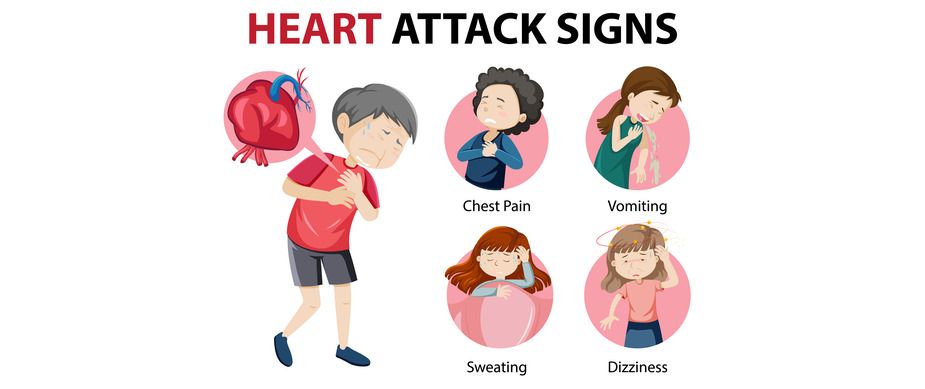Introduction
A heart attack can strike without warning. Many people mistake the early signs for simple discomfort or fatigue, losing precious time before help arrives. Recognizing the symptoms early can save your life or someone else’s. When you understand what to look for and act fast, you give emergency responders the best chance to restore heart function. This quick guide explains the warning signs, what to do in an emergency, and how to stay prepared.
What Happens During a Heart Attack
A heart attack occurs when the flow of blood to the heart muscle is blocked. Most often, this happens due to a buildup of fat, cholesterol, or plaque inside the arteries. When the blood supply is cut off, heart tissue begins to die. The longer the delay, the greater the damage.
Acting within the first few minutes can reduce complications and improve recovery. Every moment counts.
Common Warning Signs to Watch For
Heart attack symptoms are not always dramatic. Some start slowly and build over time. Knowing the key warning signs helps you act before it’s too late.
Look for these symptoms:
- Pressure, tightness, or pain in the chest that lasts more than a few minutes
- Pain spreading to the shoulders, arms, neck, jaw, or back
- Shortness of breath, even at rest
- Cold sweat or clammy skin
- Nausea, indigestion, or sudden dizziness
Some people experience mild discomfort instead of sharp pain. Never ignore these signals, especially if they appear during rest or physical activity.
Differences Between Men and Women
Men and women may experience heart attack symptoms differently. Women are more likely to have subtle signs that are easy to overlook.
Men often feel:
- Chest pain or pressure
- Left arm pain
- Sudden collapse
Women may feel:
- Fatigue without clear reason
- Nausea or vomiting
- Pain in the upper back or jaw
- Lightheadedness or fainting
Because these signs seem unrelated to the heart, women sometimes delay seeking help. Quick recognition can prevent serious outcomes.
What to Do Immediately
If you suspect a heart attack, time is your biggest enemy. Take these steps right away:
- Call emergency services without delay.
- Have the person sit down and stay calm.
- Loosen any tight clothing.
- If available, give one adult-strength aspirin to chew, unless allergic or told not to by a doctor.
- Keep monitoring breathing and responsiveness.
If the person loses consciousness and stops breathing, begin CPR immediately. Push hard and fast in the center of the chest at a rate of 100 to 120 compressions per minute until help arrives.
Learning CPR in advance prepares you to handle this critical situation confidently. You can learn these life-saving steps through MyCPR NOW, which offers easy, clear instruction for anyone who wants to be prepared.
Silent Heart Attacks
Not every heart attack causes noticeable pain. Silent heart attacks can occur with little or no warning. They may feel like mild heartburn, tiredness, or shortness of breath.
People with diabetes, high blood pressure, or high cholesterol are at greater risk. Regular checkups and awareness of subtle symptoms can prevent long-term heart damage.
After a Heart Attack: The Road to Recovery
Getting medical attention fast is the first step toward recovery. Once the heart is stabilized, follow-up care is crucial. Recovery includes:
- Taking prescribed medication on schedule
- Following a heart-healthy diet
- Avoiding smoking and alcohol
- Joining a cardiac rehabilitation program
- Managing stress and getting regular exercise
Lifestyle changes help strengthen the heart and reduce the risk of another event.
Preventing Future Heart Attacks
Prevention starts with understanding your health risks and making consistent, smart choices. You can lower your chances of heart problems by:
- Eating balanced meals with fruits, vegetables, and whole grains
- Exercising at least 30 minutes most days of the week
- Maintaining a healthy weight
- Checking blood pressure and cholesterol regularly
- Getting enough sleep and managing stress
Small daily changes make a big difference over time.
Why Early Action Saves Lives
During a heart attack, each passing minute means more heart cells are deprived of oxygen. The faster treatment begins, the more tissue can be saved. Recognizing symptoms early and calling for help immediately can double the survival rate. Delaying even ten minutes can make recovery harder and increase complications.
The Power of CPR Training
Cardiac arrest can occur suddenly during or after a heart attack. Knowing CPR gives you the ability to respond instantly and maintain circulation until emergency services arrive. It also builds confidence to act instead of freezing in panic.
You can strengthen your emergency response skills with MyCPR NOW. Their programs make it easy for anyone to learn CPR and first aid without prior experience.
Conclusion
Recognizing heart attack symptoms and acting fast saves lives. Chest pain, shortness of breath, or unexplained fatigue should never be ignored. Quick action, calm thinking, and proper CPR can make the difference between life and death. By learning these skills through MyCPR NOW, you take an important step toward protecting yourself and others. Every heartbeat matters, and being ready ensures you can respond when it counts the most.
